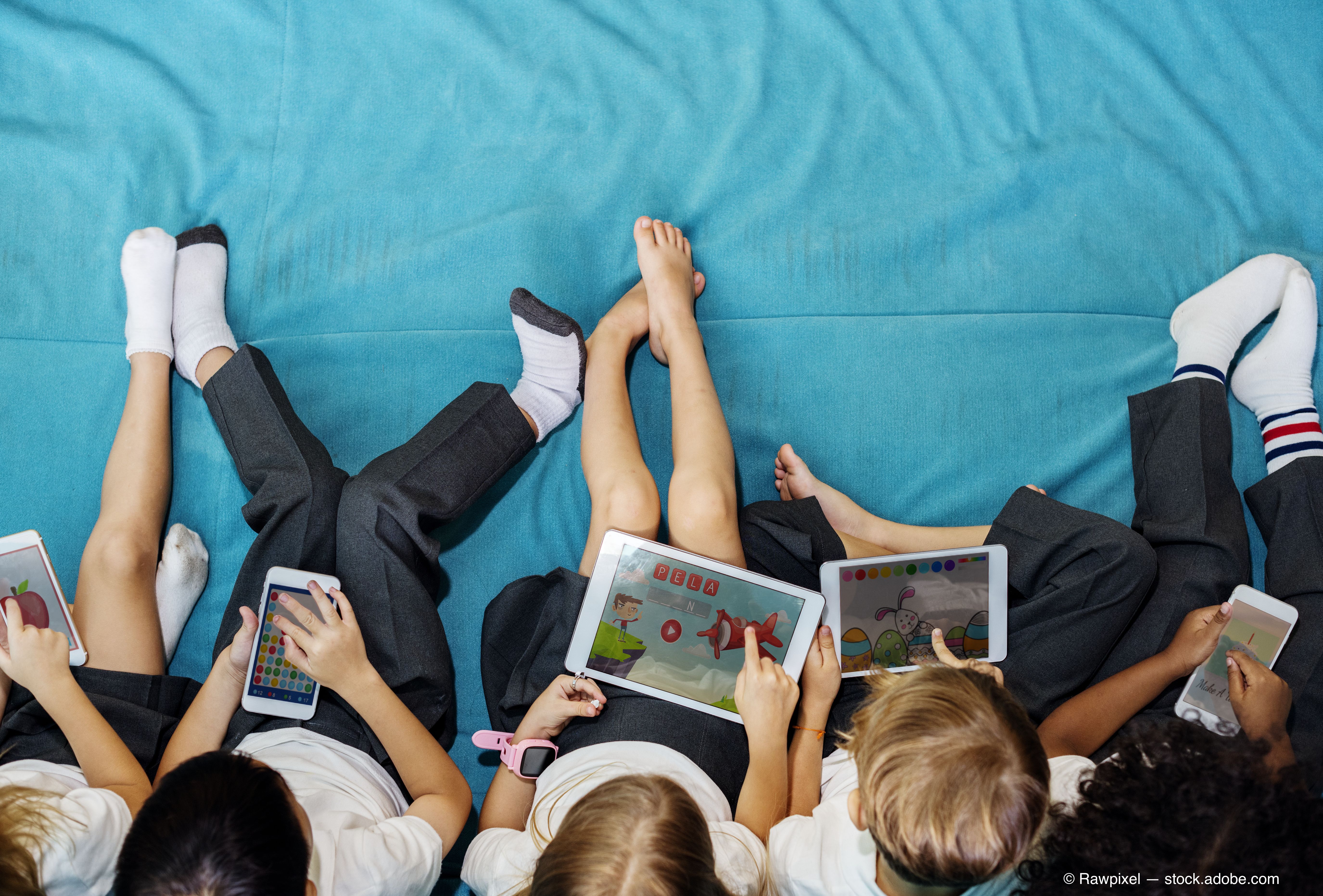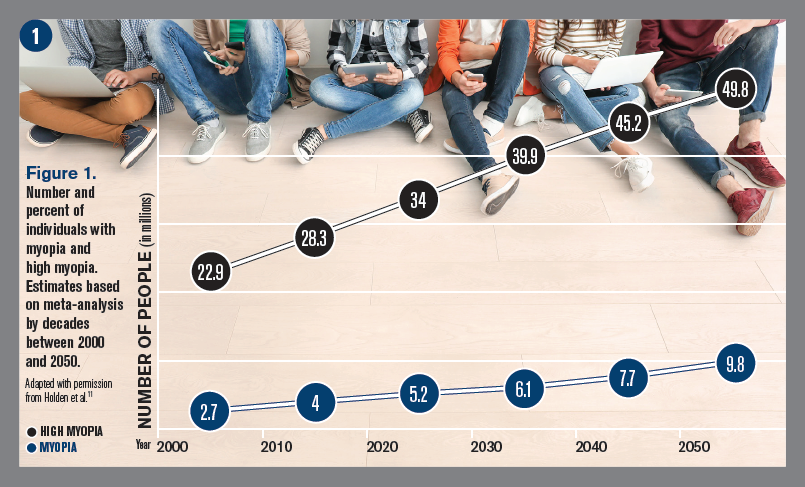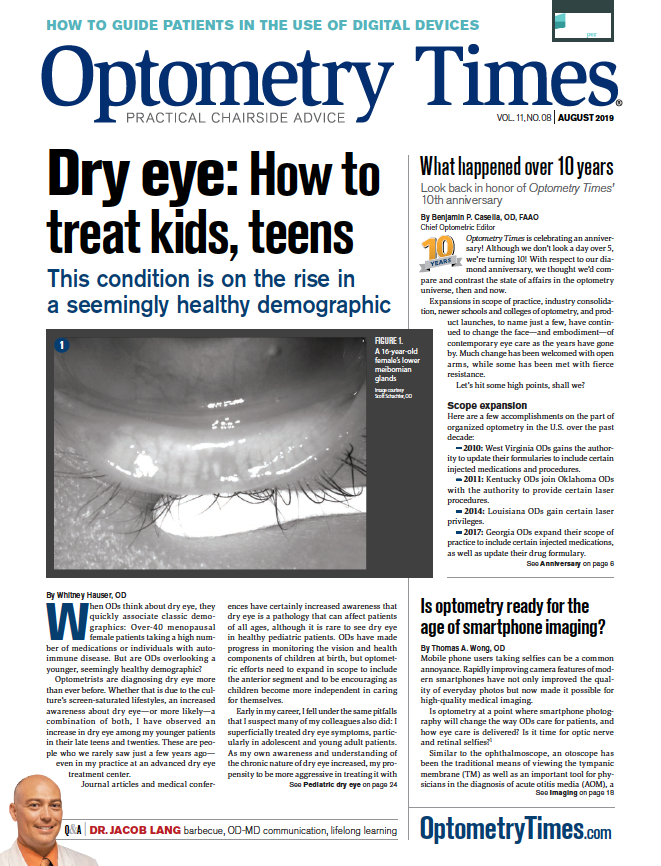The possible connection among kids, devices, and myopia

Myopia is experiencing an epidemic rise across the world, most dramatically among younger people (college educated and high school graduates) in East and South Asia where the prevalence has reached almost 100 percent in some demographics.1-6
Myopia is now one of the leading causes of vision impairment and blindness in the world.7 The prevalence of myopia has increased steadily during the last half of the 20th century and into the 21st century in most parts of the world,1,8-10 and is estimated to affect 50 percent of the world’s population by 2050 (Figure 1).1,8-11

The increasing prevalence of myopia has emerged as a global health concern because of sight-threating pathologies like myopic macular degeneration, choroidal neovascularization, cataract, and glaucoma associated with high myopia.12Related: How to build a myopia control practice
Myopia mechanism
Despite creating a major health burden, the exact mechanisms of myopic eye growth and its progression, particularly in the juvenile population, remain unknown.13
Hyperopic eyes of human infants and of infant monkeys made hyperopic with negative trial lenses experience coordinated growth, resulting in longer eyes and a refractive trend toward emmetropia (emmetropization).12,14 Juvenile myopia can be considered a failure of emmetropization or a possible reactivation of the emmetropization mechanisms in later childhood in response to chronic hyperopic defocus produced by habitual near viewing and accommodative lags.15
The second hypothesis could reflect eyes successfully adapting to the modern (near) environment. The high prevalence of myopia among populations that spend a lot of time doing near vision tasks (school children, high school and college students, and those in religious seminaries) further support the hypothesis that hyperopic defocus (central or peripheral) generated by accommodative lags during near work could stimulate eye growth (Figure 2).16-18Related: How to control myopia progression in your practice
Technology’s role
Several important technological developments have occurred during the same general time period as the emergence of the myopia epidemic:
• The number of digital information sources (Internet host sites) climbed from about 100 in 1980 to 1 billion by 2012.19
• In the early 2000s, the number of worldwide smartphone users were reported to be 1.85 billion (190 million in U.S.) and are projected to rise to about 3 billion (272 million in U.S.) by 2020.20,21
• Total worldwide cellphone subscription rate has exceeded the 7.5 billion worldwide population, passing over 8 billion in 2018.22
• People are now engaged in viewing behaviors unavailable prior to the 21st century, such as entertainment videos, photos, Internet, social media, and work-related viewing on a display that may be only a few centimeters wide.23
The progressive improvement in spatial resolution of electronic displays from video home system (VHS) in the 1970s is astounding. This increased resolution has resulted in a corresponding reduction in display sizes, yielding high-quality handheld displays of only 14 x 7 cm that can be viewed at distances less than 25 cm without detection of individual pixels.23Related: How digital device usage is affecting youth
A 2017 report by the nonprofit Common Sense Media suggests that in the U.S., 98 percent of households with children under 8 years of age have a mobile device.24 Plus, 42 percent of children age 8 and younger and 66 percent of teens and tweens aged 8-18 years have their own mobile devices.25 The average usage time in this young and adolescent group is reported to exceed 4 hours and 6 hours per day, respectively.24,25
With advancement in technology over time, electronic display viewing is transitioning from traditional computers to handheld personal devices and thus, increased exposure time at short viewing distances.26
Could these changes be implicated in the worldwide myopia epidemic? Have we become victims of our own technological success?
Related: Know the legal aspects of myopia control
New research
In a recent study, my colleagues and I examined the accommodative accuracy of emmetropic and myopic children as they viewed a range of targets displayed on electronic devices.
We used a sensitive autorefractometer (WAM-5550) to monitor refractive states of children (sampling frequency= 5Hz) as targets were moved from distance (4 m) to near (20 cm).
We found that, at near, small amounts of hyperopic defocus were present in all children. At viewing distances typically employed with handheld electronic devices (33-20 cm), emmetropic and myopic children experienced similar lags (mean 0.54 and 0.32 D, respectively) to those previously reported with printed materials.27,28
We found no evidence that electronic displays generated elevated accommodative lags and elevated magnitudes of hyperopic defocus. Therefore, if electronic displays are a causative factor in myopia development, it is likely due to increased duration of exposure to near targets, not the magnitude of the hyperopic defocus they produce.29
Moreover, the increased exposure to sunlight during time spent outdoors increases the release of retinal neurotransmitter dopamine which has been postulated as a preventive factor for myopia progression.30,34 With increased use of electronic devices, children may be less motivated to play or spend time outdoors and may prefer to remain indoors. 31-33
For example, estimates from 2012 indicate that in the U.S., juveniles spend 35 times more time on screens/electronic devices than in vigorous physical activity (7 hours 11 minutes per day on screens versus 12.6 minutes in physical activity).34,35Related: How to recognize and manage digital eye strain

Slowing myopia
Consistent with the “failure of homeostasis”15 (an emmetropic eye failing to remain so with time) or alternatively a reactivation of emmetropization mechanisms in response to hyperopic defocus, several strategies have been implemented worldwide in efforts to avoid myopia or to slow myopia progression by reducing chronic exposure to hyperopic defocus in juveniles.
Bifocal spectacles and progressive addition lenses (PALs) were the first line of treatment and reported to relieve optical blur as a result of prolonged accommodation.31
Another approach sought to remove hyperopic defocus from the peripheral retina by introducing myopic refractions in the peripheral cornea via orthokeratology or multifocal contact lenses designs.36
A pharmacological tactic with drugs inducing cycloplegic effects (atropine and pirenzepine) has also been used to slow myopia progression.37,38
Related: Treating and diagnosing myopia
Other methods to prevent children from using short viewing distances for prolonged duration include putting mechanical bars on school desks in China, software interventions in smartphones which flicker warnings if used too closely, and increasing outdoor play time.39-41
Earlier onset of myopia is associated with larger amounts of myopia later in life, increasing the loss of sight risks linked to high myopia.42,43 Similarly, having early emmetropia (absence of significant hyperopia-<+0.50 D) at school entry is reported to be a major risk factor for later myopia development.31
A study of school children in Taiwan reports that outdoor activity during school recess delayed the onset of myopia, supported by a 2017 meta-analysis.41,44 Increased time outdoors, however, failed to slow myopia progression in already myopic eyes.44
These reports converge to suggest that adopting preventive measures early in life is essential to delay the onset of myopia, which might then prevent higher amounts of myopia later in life.
Our study reveals that children using personal electronic devices will experience accommodative lags (hyperopic defocus)-but despite this, at this time no direct link has been established between the usage time for handheld electronic devices and myopia development. Further research is warranted to continue to explore the relationship of modern digital devices in myopia development-this is a question that needs an answer in the modern technological world we now live in.
Read more technology content
References:
1. Pan CW, Dirani M, Cheng CY, Wong TY, Saw SM. The age-specific prevalence of myopia in Asia: a meta-analysis. Optom Vis Sci. 2015 Mar;92(3):258-266.
2. Chen M, Wu A, Zhang L, Wang W, Chen X, Yu X, Wang K .The increasing prevalence of myopia and high myopia among high school students in Fenghua city, eastern China: a 15-year population-based survey. BMC Ophthalmol. 2018 Jul 3;18(1):159.
3. Wu LJ, You QS, Duan JL, Luo YX, Liu LJ, Li X, Gao Q, Zhu HP, He Y, Xu L, Jonas JB, Wang W, Guo XH. Prevalence and associated factors of myopia in high-school students in Beijing. PLoS One. 2015 Mar 24;10(3):e0120764.
4. Jung SK, Lee JH, Kakizaki H, Jee D. Prevalence of myopia and its association with body stature and educational level in 19-year-old male conscripts in seoul, South Korea. Invest Ophthalmol Vis Sci. 2012 Aug 15;53(9):5579-83.
5. Lin LL, Shih YF, Hsiao CK, Chen CJ. Prevalence of myopia in Taiwanese schoolchildren: 1983 to 2000. Ann Acad Med Singapore. 2004 Jan;33(1):27-33.
6. Lam CSY, Goldschmidt E, Edwards MH. Prevalence of myopia in local and international schools in Hong Kong. Optom Vis Sci. 2004 May;81(5):317-322.
7. Flaxman SR, Bourne RRA, Resnikoff S, Ackland P, Braithwaite T, Cicinelli MV, Das A, Jonas JB, Keeffe J, Kempen JH, Leasher J, Limburg H, Naidoo K, Pesudovs K, Silvester A, Stevens GA, Tahhan N, Wong TY, Taylor HR; Vision Loss Expert Group of the Global Burden of Disease Study. Global causes of blindness and distance vision impairment 1990-2020: a systematic review and meta-analysis. Lancet Glob Health. 2017 Dec;5(12):e1221-e1234.
8. Bar Dayan Y, Levin A, Morad Y, Grotto I, Ben-David R, Goldberg A, Onn E, Avni I, Levi Y, Benyamini OG. The changing prevalence of myopia in young adults: a 13-year series of population-based prevalence surveys. Invest Ophthalmol Vis Sci. 2005 Aug;46(8):2760-5.
9. Vitale S, Sperduto RD, Ferris FL. Increased prevalence of myopia in the United States between 1971-1972 and 1999-2004. Arch Ophthalmol. 2009 Dec;127(12):1632-9.
10. Williams KM, Verhoeven VJ, Cumberland P, Bertelsen G, Wolfram C, Buitendijk GH, Hofman A, van Duijn CM, Vingerling JR, Kuijpers RW, Höhn R, Mirshahi A, Khawaja AP, Luben RN, Erke MG, von Hanno T, Mahroo O, Hogg R, Gieger C, Cougnard-Grégoire A, Anastasopoulos E, Bron A, Dartigues JF, Korobelnik JF, Creuzot-Garcher C, Topouzis F, Delcourt C, Rahi J, Meitinger T, Fletcher A, Foster PJ, Pfeiffer N, Klaver CC, Hammond CJ. Prevalence of refractive error in Europe: the European Eye Epidemiology (E(3)) Consortium. Eur J Epidemiol. 2015 Apr;30(4):305-15.
11. Holden BA, Fricke TR, Wilson DA, Jong M, Naidoo KS, Sankaridurg P, Wong TY, Naduvilath TJ, Resnikoff S. Global Prevalence of Myopia and High Myopia and Temporal Trends from 2000 through 2050. Ophthalmology. 2016 May;123(5):1036-42.
12. Morgan IG, Ohno-Matsui K, Saw SM. Myopia. Lancet. 2012 May 5;379(9827):1739-48.
13. Guo L, Yang J, Mai J, Du X, Guo Y, Li P, Yue Y, Tang D, Lu C, Zhang WH. Prevalence and associated factors of myopia among primary and middle school-aged students: a school-based study in Guangzhou. Eye (Lond). 2016 Jun;30(6):796-804.
14. Smith EL 3rd, Hung LF. The role of optical defocus in regulating refractive development in infant monkeys. Vision Res. 1999 Apr;39(8):1415-35.
15. Flitcroft DI. Is myopia a failure of homeostasis? Exp Eye Res. 2013 Sep;114:16-24.
16. Rose KA, Morgan IG, Ip J, Kifley A, Huynh S, Smith W, Mitchell P. Outdoor activity reduces the prevalence of myopia in children. Ophthalmology. 2008 Aug;115(8):1279-1285.
17. Sherwin JC, Reacher MH, Keogh RH, Khawaja AP, Mackey DA, Foster PJ. The association between time spent outdoors and myopia in children and adolescents. Ophthalmology. 2012 Oct;119(10):2141-2151.
18. Zylbermann R, Landau D, Berson D. The influence of study habits on myopia in Jewish teenagers. J Pediatr Ophthalmol Strabismus. 1993 Sep-Oct;30(5):319-22.
19. Wikipedia. Internet Systems Consortium. Available at: https://en.wikipedia.org/wiki/Internet_Systems_Consortium. Accessed 8/3/19.
20. Statista. Number of smartphone users worldwide 2014-2020. https://www.statista.com/statistics/330695/number-of-smartphone-users-worldwide/. Accessed 8/3/19.
21. Statista. Smartphones in the U.S. https://www.statista.com/study/26643/smartphones-in-the-us-statista-dossier/. Accessed 8/3/19.
22. IC Insights. Worldwide Cellphone Subscriptions Forecast to Exceed Worldwide Population in 2015! Available at: http://www.icinsights.com/news/bulletins/Worldwide-Cellphone-Subscriptions-Forecast-To-Exceed-Worldwide-Population-In-2015/. Accessed 8/3/19.
23. Apple. iPhone XS Technical Specifications. Available at: https://www.apple.com/iphone-xs/specs/. Accessed 8/3/19.
24. Common Sense Media. The Common Sense: Media use by teens and tweens. Available at: https://www.commonsensemedia.org/sites/default/files/uploads/research/census_researchreport.pdf. Accessed 8/3/19.
25. Twenge JM, Martin GN, Spitzberg BH. Trends in U.S. Adolescents’ media use, 1976–2016: The rise of digital media, the decline of TV, and the (near) demise of print. Psy Pop Media Culture. 2018 Aug 20.
26. Gibbs S. Mobile web browsing overtakes desktop for the first time. The Guardian. Available at: https://www.theguardian.com/technology/2016/nov/02/mobile-web-browsing-desktop-smartphones-tablets. Accessed 8/3/19.
27. Bababekova Y, Rosenfield M, Hue JE, Huang RR. Font size and viewing distance of handheld smart phones. Optom Vis Sci. 2011 Jul;88(7):795-7.
28. Gwiazda J, Thorn F, Bauer J, Held R. Myopic children show insufficient accommodative response to blur. Invest Ophthalmol Vis Sci. 1993 Mar;34(3):690-4.
29. Saw SM, Zhang MZ, Hong RZ, Fu ZF, Pang MH, Tan DT. Near-work activity, night-lights, and myopia in the Singapore-China study. Arch Ophthalmol. 2002 May;120(5):620-7.
30. Guggenheim JA, Northstone K, McMahon G, Ness AR, Deere K, Mattocks C, Pourcain BS, Williams C. Time outdoors and physical activity as predictors of incident myopia in childhood: a prospective cohort study. Invest Ophthalmol Vis Sci. 2012 May 14;53(6):2856-65.
31. Mutti DO, Zadnik K. The utility of three predictors of childhood myopia: a Bayesian analysis. Vision Res. 1995 May;35(9):1345-52.
32. Street-Porter J. Our kids are spending less time outdoors than prisoners – it’s time for families to rediscover the great British beach. Independent. Available at: https://www.independent.co.uk/voices/our-kids-are-spending-less-time-outdoors-than-prisoners-its-time-for-families-to-rediscover-the-a8357311.html. Accessed 8/3/19.
33. Kennedy R. Children spend half the time playing outside in comparison to their parents Child in the City. Available at: https://www.childinthecity.org/2018/01/15/children-spend-half-the-time-playing-outside-in-comparison-to-their-parents/?gdpr=accept. Accessed 8/2/19.
34. Linn S, Almon J, Levin D. Facing the Screen Dilemma: Young Children, Technology and Early Education. Campaign for a Commercial-Free Childhood. Available at: https://www.commercialfreechildhood.org/sites/default/files/facingthescreendilemma.pdf. Accessed 8/3/19.
35. Juster FT, Ono H, Stafford FP. Changing Times of American Youth: 1981-2003. Institute for Social Research. Available at: http://ns.umich.edu/Releases/2004/Nov04/teen_time_report.pdf. Accessed 8/3/19.
36. Walline JJ. Myopia Control: A Review. Eye Contact Lens. 2016 Jan;42(1):3-8.
37. Chia A, Chua WH, Cheung YB, Wong WL, Lingham A, Fong A, Tan D Atropine for the treatment of childhood myopia: safety and efficacy of 0.5%, 0.1%, and 0.01% doses (Atropine for the Treatment of Myopia 2). Ophthalmology. 2012 Feb;119(2):347-54
38. Siatkowski RM, Cotter SA, Crockett RS, Miller JM, Novack GD, Zadnik K; U.S. Pirenzepine Study Group. Two-year multicenter, randomized, double-masked, placebo-controlled, parallel safety and efficacy study of 2% pirenzepine ophthalmic gel in children with myopia. J AAPOS. 2008 Aug;12(4):332-9.
39. Macrae F. Why a school has put its pupils behind bars: Reading aid for children at risk of short-sightedness. Daily Mail. Available at: https://www.dailymail.co.uk/news/article-2564980/Thats-one-way-control-pupils-Chinese-school-protects-childrens-eyesight-installing-bars-prevent-getting-close-books.html. Accessed 8/2/19.
40. Jaskulski M, López-Gil N, Liu Y. Using the smartphone to measure near work distance. Paper presented at: International Myopia Conference; Birmingham, UK; September 14-17, 2017.
41. Wu PC, Tsai CL, Wu HL, Yang YH, Kuo HK. Outdoor activity during class recess reduces myopia onset and progression in school children. Ophthalmology. 2013 May;120(5):1080-5.
42. Saw SM, Chua WH, Hong CY, Wu HM, Chan WY, Chia KS, Stone RA, Tan D. Nearwork in early-onset myopia. Invest Ophthalmol Vis Sci. 2002 Feb;43(2):332-9.
43. Chua SY, Sabanayagam C, Cheung YB, Chia A, Valenzuela RK, Tan D, Wong TY, Cheng CY, Saw SM. Age of onset of myopia predicts risk of high myopia in later childhood in myopic Singapore children. Ophthalmic Physiol Opt. 2016 Jul;36(4):388-94.
44. Xiong S, Sankaridurg P, Naduvilath T, Zang J, Zou H, Zhu J, Lv M, He X, Xu X. Time spent in outdoor activities in relation to myopia prevention and control: a meta-analysis and systematic review. Acta Ophthalmol. 2017 Sep;95(6):551-566.

Newsletter
Want more insights like this? Subscribe to Optometry Times and get clinical pearls and practice tips delivered straight to your inbox.